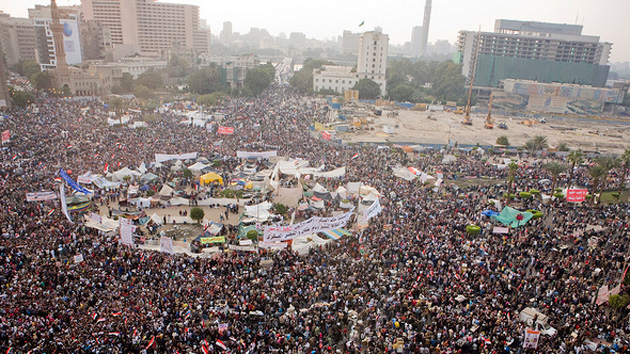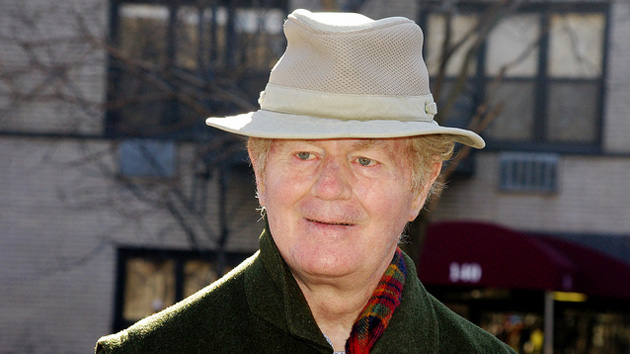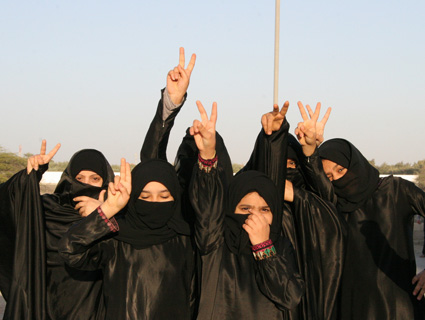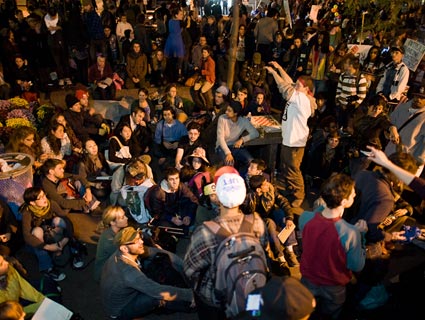
Protests at Tahrir Square in Cairo, Egypt, in 2011.<a href="https://www.flickr.com/photos/elhamalawy/6401023697/in/photolist-aKsJhr-9gsYEB-9fB9xK-9dYbEX-9eB2k4-9e2fno-aKCVkx-9eEabY-9fBbLc-9Y4Wk7-aHCByT-9ekAMS-9e2cGu-5GYQ52-kYAUCJ-9hoEqx-aJpsqg-arQhdU-9e2eWQ-9kXYcM-9hrNR7-arQfu3-aHRsfV-aMX2B6-9fBbp8-9dY9T6-9ehkTx-aKJG3V-bBXjMV-9yESu5-9ekwWU-9yBSzF-9ehwCT-arMAGv-aKFPZX-9fEhrm-9ehrqp-awCRPx-9ekAds-9HDyTV-9eB1Ni-9ekBuN-hB2VHC-arMyji-aKHJxx-arMgix-aFPvtX-9f3KLc-9ffEJ6-4TXWNs">Hossam el-Hamalawy</a>/Flickr
This story first appeared on the TomDispatch website.
Three and a half years ago, the world was riveted by the massive crowds of youths mobilizing in Cairo’s Tahrir Square to demand an end to Egypt’s dreary police state. We stared in horror as, at one point, the Interior Ministry mobilized camel drivers to attack the demonstrators. We watched transfixed as the protests spread from one part of Egypt to another and then from country to country across the region. Before it was over, four presidents-for-life would be toppled and others besieged in their palaces.
Some 42 months later, in most of the Middle East and North Africa, the bright hopes for more personal liberties and an end to political and economic stagnation championed by those young people have been dashed. Instead, a number of Arab countries have seen counter-revolutions, while others are engulfed in internecine conflicts and civil wars, creating Mad Max-like scenes of post-apocalyptic horror. But keep one thing in mind: the rebellions of the past three years were led by Arab millennials, twentysomethings who have decades left to come into their own. Don’t count them out yet. They have only begun the work of transforming the region.
Given the short span of time since Tahrir Square first filled with protesters and hope, care should be taken in evaluating these massive movements. During the Prague Spring of 1968, for instance, a young dissident playwright, Vaclav Havel, took to the airwaves on Radio Free Czechoslovakia and made a name for himself as Soviet tanks approached. After the Russian invasion, he would be forbidden to stage his plays and 42 months after the Prague Spring was crushed, he was working in a brewery. Only after the fall of the Berlin Wall in 1989 would he emerge as the first president of the Czech Republic.
Three and a half years into the French Revolution, the country was only months away from the outbreak of a pro-royalist Catholic peasant revolt in the Vendée, south of the Loire Valley. The resulting civil war with the republicans would leave more than 100,000 (and possibly as many as 450,000) people dead.
Preparing the Way for a New Arab Future
There are of course plenty of reasons for pessimism in the short and perhaps even medium term in the Middle East. In Egypt, Ahmad Maher, a leader of the April 6 Youth, famed for his blue polo shirts and jaunty manner, went from advising the prime minister on cabinet appointments in the summer of 2011 to a three-year prison term at hard labor in late 2013 for the crime of protesting without a license. Other key revolutionaries of 2011, like dissident blogger Alaa Abdel Fattah and leftist activist and organizer Mahienoor El Masry, are also in jail, along with many journalists, including three from Al Jazeera, two sentenced to seven years in jail and one to 10, simply for doing the most basic reporting imaginable.
When it comes to youth revolutions, however, it’s a pretty good bet that most of their truest accomplishments will come at least a couple of decades later. The generation of young Arabs who made the revolutions that led to the unrest and civil wars of the present is in fact distinctive— substantially more urban, literate, media-savvy, and wired than its parents and grandparents. It’s also somewhat less religiously observant, though still deeply polarized between nationalists and devotees of political Islam.
And keep in mind that the median age of the 370 million Arabs on this planet is only 24, about half that of graying Japan or Germany. While India and Indonesia also have big youth bulges, Arab youth suffer disproportionately from the low rates of investment in their countries and staggeringly high unemployment rates. They are, that is, primed for action.
“Youth” as a category is always going to encompass very diverse populations, but it’s the self-conscious activists claiming to act in the name of their generation who make youth movements. Not all age cohorts in modern Arab history have created organizations on the basis of generational aspirations and discontents (as some of the Baby Boomers did in the 1960s in the United States). However, the Arab youth born roughly between the years 1980 and 2000, who came into their own in the new century, have organized a plethora of generationally based movements, many named for the dates of their initial demonstrations, including April 6 Youth, Revolutionaries Libya 17, and Reunion.
In the brief period when they were riding high, they routinely spoke of themselves self-consciously as “youth” and made demands no less self-consciously in the name of their “generation.” The two most famous of those demands were “the people want the fall of the regime” and (especially in Egypt) “bread, freedom, and social justice.” Many of these groups are now banned by counter-revolutionary generals or by restored and ascendant secret police, while others have faded away in the face of the rise of paramilitary forces and militias— the very opposite of engaged youth movements and deadly to their open-minded values.
Even banished or suppressed, however, their contributions to political life in the region should not be discounted. And where they still exist, they matter. In the summer and fall of 2013 in Tunisia, for instance, youth organizations allied with the country’s major labor union to pressure the government, led by a party of the religious right, to step down in preparation for new elections and to allow principles like women’s equality to be put into a new constitution.
Three Achievements of the Arab Spring
Two or three decades from now, the twentysomethings of Tahrir Square or the Casbah in Tunis or Martyrs’ Square in Tripoli will, like the Havels of the Middle East, come to power as politicians. For that we have to wait. In the meantime, we can at least try to understand just what their movements have meant for the region. Those tea leaves are, after all, in plain sight and ready to be read.
Here are three of their achievements that seem likely to be lasting, whatever the upheaval in the region:
1. The emergence of dynasties and family cartels as the leadership of the Arab republics has been rejected.
Back in 2000, sociologist Saad Eddin Ibrahim coined the phrase jumlukiyyah, a melding of the Arabic words for “republic” and “monarchy.” This phenomenon of “monarpublicanism,” he pointed out, was the dynastic principle that then governed the leadership succession in much of the Middle East. Unlike in republics elsewhere in which unrelated presidents and prime ministers are supposed to succeed one another in accordance with the popular will, Ibrahim suggested that the way Bashar al-Assad succeeded his father Hafez in Syria was a bellwether for the region.
Saif al-Islam Gaddafi seemed poised to eventually take over from his mercurial father, Muammar, in Libya. Hosni and Suzanne Mubarak were said to be grooming their younger son Gamal to step into the presidency after the old man passed from the scene in Egypt. In Yemen, President for Life Ali Abdallah Saleh was promoting his son Ahmad, a general in the army, as his successor. Tunisian President Zine El Abidine Ben Ali ‘s presidential palace was being eyed by his wife, social climber Leila Trabelsi, and his son-in-law, billionaire Sakher El Materi.
Ibrahim was jailed by a petty and vindictive Egyptian regime simply for being a sociologist and observing the reality around him (even if he was ultimately acquitted of wrongdoing). One goal of the youth movements in Egypt and elsewhere was distinctly Ibrahimist: to destroy the principle of monarpublicanism, turn out those presidents-for-life, and ensure that their children did not succeed them. All of them were to be made accountable for their family crimes after free and fair elections.
 Because of those youth revolutions, Hafez al-Assad of Syria was the sole republican monarch who passed his country on to his son— and even then, Bashar has been able to cling to power in just half of his country and only by resorting to atrocities so extensive that they amount to crimes against humanity. Elsewhere, the crown princes of the corrupt old republics are often in exile, court, or prison. Saif al-Islam Gaddafi is on trial in Tripoli. Tunisia is attempting to extradite Sakher al-Materi from the Seychelles Islands. Gamal Mubarak is on trial for stock exchange manipulation. General Ahmad Ali Saleh, the son of the deposed dictator, is being investigated on charges of embezzlement, while his father, accused of plotting a coup, has lost much of his remaining power.
Because of those youth revolutions, Hafez al-Assad of Syria was the sole republican monarch who passed his country on to his son— and even then, Bashar has been able to cling to power in just half of his country and only by resorting to atrocities so extensive that they amount to crimes against humanity. Elsewhere, the crown princes of the corrupt old republics are often in exile, court, or prison. Saif al-Islam Gaddafi is on trial in Tripoli. Tunisia is attempting to extradite Sakher al-Materi from the Seychelles Islands. Gamal Mubarak is on trial for stock exchange manipulation. General Ahmad Ali Saleh, the son of the deposed dictator, is being investigated on charges of embezzlement, while his father, accused of plotting a coup, has lost much of his remaining power.
Youth opposition to the emergence of royal dynasties in the Arab republics sprung not just from a distaste for the betrayal of republican political principles but from a conviction that such ruling families had become corrupt, nepotistic cartels. As the US embassy in Tunis observed in 2006, “In Tunisia’s small subset of commercial actors, it seems at least half of the elite are rumored to be somehow related or connected to the President.”
In such circumstances, licenses for companies, jobs in the state bureaucracy, and other economic opportunities were monopolized by and for the ruling family and its circle of cronies. The protesters saw this level of corruption as a brake on economic growth, leaving those outside the charmed circle doomed to work as menials, to unemployment, or to exile abroad. Worse, if the plans for non-royal succession were implemented, these exclusionary, corrupt, and stagnant systems would be perpetuated many decades into the future.
Jumlukiyyah is now in the junk heap of history.
2. The age of presidents-for-life and complete lack of political accountability is coming to a close.
Even in neo-authoritarian Egypt, the new constitution allows a president only two four-year terms. In some Arab countries, politicians have begun showing a willingness to step down when the public demands accountability or in order to uphold the rule of law or simply to avoid looking like the autocrats who had been angrily overthrown. In response to a public outcry, Tunisian Prime Minister Ali Larayedh of the ruling Renaissance (al-Nahdah) Party, the largest in parliament, did so in early January in favor of a technocratic cabinet, which could be expected to fairly oversee new parliamentary elections. It was the first voluntary civilian succession in the country’s history.
This May in Libya, a complete security mess, the minority Muslim Brotherhood faction in parliament and its allies attempted to put one of their own in the prime ministerial slot. They claimed that conservative businessman Ahmad Maitig had been elected with the requisite 120 votes; the nationalist opposition insisted he had only collected 113. When the issue went to Libya’s supreme court and it ruled against him, Maitig relinquished his claim, citing the need to uphold the rule of law, and joining the ranks of Larayedh and other leaders who declined to cling to power and risk further polarization of their fragile societies.
Iraq stands in contrast, and serves as an object lesson in this regard. Arab Spring protests broke out there in both Sunni and Shiite areas in early 2011. In response, Prime Minister Nouri al-Maliki initially pledged not to seek a third term. He soon thought better of the promise. Nonetheless, Sunni Arab youth in Fallujah and elsewhere continued to use techniques borrowed from the Tahrir movement to highlight their marginalization in Shiite-dominated Iraq.
Early in 2013, Maliki’s troops shot down Sunni demonstrators coming to Fallujah, which led to further youth protests and demands for accountability for those deaths. The government responded with more force. Had Maliki accommodated the demands of those demonstrators, in both Sunni and Shiite areas, he might have been able to forge new forms of national unity. Instead, by crushing the civil youth movements, he left the door open to the radical insurgents of the Islamic State of Iraq and Syria.
3. A more multicultural vision of how society should work is now on the Arab agenda.
Previous generations of Arab leaders and movements were often blind to the ways in which pride in the heritage of Arabic-speaking peoples could shade into discriminatory attitudes toward non-Arabs in Muslim-majority states. Sometimes such societies had difficulty treating non-Muslims as equals. Many youth activists were (and remain) dedicated to a more multicultural vision of Arab society.
The attempt of elected Egyptian President Muhammad Morsi of the Muslim Brotherhood to rule through a clique of fundamentalists (who constitute a minority of Egyptians) deeply offended activist youth. Morsi rejected the idea of a government of national unity despite his narrow margin of victory and instead filled high offices with fundamentalist allies. Last year, he was overthrown, at least in part because millions of youth and workers again took to the streets. In the aftermath, explicitly religious or sectarian parties have been banned— though the military, which backed the mobilization of the young against Morsi, is again ascendant and has now turned on them, too.
The 2011 youth movement in Egypt also sought Christian-Muslim unity. In Tahrir Square on Fridays, Coptic Christian youth would stand guard while Muslims prayed. On Sundays, Muslim activists protected Christians as they held open-air masses. Youth activists were disgusted when Muslim Brotherhood rule meant the bringing of blasphemy charges against Coptic schoolteachers. Even North Africa’s most serious ethnic divide, between Arabs and minority Berbers or Amazigh, shows signs of beginning to be ameliorated in Morocco under the pressure of the 2011 protests.
Like much of the rest of the Arab Spring, the urge of the millennial generation across North Africa and the Middle East for a more multicultural world seems far from realization, but they have put it on a future Arab agenda. Its moment will return.
Waiting for the Arab Summer
Analysts have tended to focus on the high politics of the Arab youth revolutions and so have missed the more important, longer-term story of a generational shift in values, attitudes, and mobilizing tactics. The youth movements were, in part, intended to provoke the holding of genuine, transparent elections in which the millennials were too young to stand for office. This ensured that actual politics would be dominated by older Arab Baby Boomers, many of whom are far more interested in political Islam or praetorian authoritarianism.
The first wave of writing about the revolutions of 2011 discounted or ignored religion because the youth movements were predominantly secular and either liberal or leftist in approach. When those rebellions provoked elections in which Muslim fundamentalists did well, a second round of books lamented a supposed “Islamic Winter.”
The “Islamic Winter” paradigm has now faded in the countries that experienced the youth revolutions, with the reassertion of the military and the nationalists in Egypt and the severe reversals the religious militias have faced in central Syria. In Libya, Muslim fundamentalist candidates could not get a majority in parliament in 2012. Similar processes have long been in train in Algeria. Even in Tunisia, where the religious right formed the first post-revolution government, they were only able to rule in coalition with secularists and leftists.
In the meantime, many of the millennial activists who briefly turned the Arab world upside down and provoked so many changes are putting their energies into non-governmental organizations, thousands of which have flowered, barely noticed, in countries that once suffered from one-party rule. In this way, they are learning valuable organizational skills that— count on it— will one day be applied to politics. Others continue to coordinate with labor unions to promote the welfare of the working classes. Their dislike of nepotism, narrow cliques, and ethnic or sectarian rule has already had a lasting impact on the politics of the Arab world. So don’t for a second think that the Arab Spring is over, no matter the news from Libya, Egypt, Iraq, or elsewhere.
Over the next two or three decades, as they come into their own politically, expect big changes in the region. Someday, there will undoubtedly be an Arab Summer and the youth of this era will be honored for what they did against all odds. Mubarak’s hired thugs attempted to ride them down with camels. That regime isn’t there anymore and the millennials are biding their time. We haven’t heard the last of their generation.
Juan Cole is Director of the Center for Middle Eastern and North African Studies at the University of Michigan. He maintains a blog on US foreign policy and progressive politics, Informed Comment. His new book, The New Arabs: How the Millennial Generation Is Changing the Middle East (Simon and Schuster), will officially be published July 1st. To stay on top of important articles like these, sign up to receive the latest updates from TomDispatch.com here.













